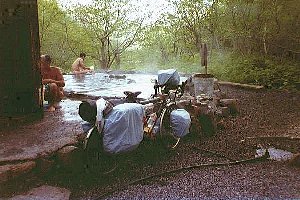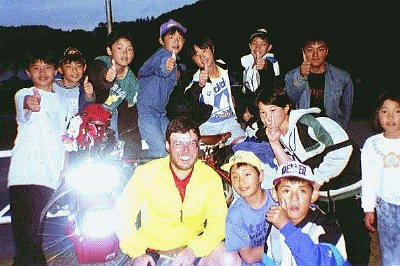
|
|
|
|
Ads by Infohub Partnership with TGCT Mutual Support with JCA |
Bill asks "What is touring in Japan like?"Rodger Grigsby answers; Good choice of cycle touring destinations, Bill! I've toured there on three separate occasions, with a total of about 4,000 miles logged on those steep hills and rugged coasts. I hope to be able to return to Japan and tour many more times: that's how good it is... So, what's so good about it??? Well, it's Safe - Clean - Beautiful - Civilized - Delicious - Beautiful, etc. etc., but for the cycle tourist there are a few things that make it especially good.
While on the subject of camping, I'll mention cooking. Unless you have a lot of money in your tour budget, you'll not want to eat out at every meal. My daily routine would usually include one restaurant meal, with the other two self-prepared, or convenience food. A typical day would be: roll over and fire up my KEROSENE fuel stove to get the "espresso machine" going (that's tour-ese for Nescafe). If I hadn't eaten them at 2:00am in a sugar orgy, I'd pull out the pastries/bread I'd purchased yesterday and have them with my coffee. At home I'd have fruit too, but in Japan fruit is a very pricey proposition, even bananas. If I'd camped near a convenience food store, which are EVERYWHERE in Japan, I'd often get my coffee and pastry there instead of firing up the barbie. By the way, in the local 7-11, or Circle K, or whatever, look for a type of hamburger-bun-like pastry called a "Kureempan": it's a sweet roll filled with delicious custard. When I last toured there with my brother Kevin in '93, if the store had only one of them we had a serious "discussion" about who would get it. They're just right to get you ready to hit the road (the LEFT side of the road: don't forget ....) When dinner time rolled
around, we'd go to a cheap noodle place for RAMEN. The real Japanese
ramen is NOT like the dry staff from Safeway:
(Editor's notes: The Chinese Character 湯 means not only the soup but also hot water. Japanese people of former days never compared Onsen with the soup. Japanese reading of that character is Yu, which originally meant water or hot water for ablution before praying.) local bath is a famous hot spring, and sometimes it's down a quiet alley and hard to find, but ask a local and they'll inevitably lead you to one, even in the big cities. I'll leave it to your further research to discover the niceties and proper etiquette for the SENTOl, but will say that for the cycle tourist there is a good "program" for ending the day. First, find the local bathhouse, then find your bivvy spot, and try to relate it to the bath (ie, less than a mile away). Don't leave your staff at the bivvy site, just get it scoped out so you can pitch camp in the dark, if need be. Second, find a restaurant near the bath, if
eating out is on the agenda. etc. Third, if you intend to have "cocktails" after your ride, purchase the beers, etc. before going to the bath, unless the liquor store is next door. You don't want to spoil that mellow after-bath glow any more than necessary.
Anyway, there's lots more that's good to know
about Japan Touring, but I hope these bits of experience will
be useful to the two-wheeled wayfarer in Nippon. And don't forget
to bring along a copy of Matsuo Basho's "Narrow Road to the
Deep North": those 300 year old haiku about HIS journey into
Japan's "backcountry" are still fresh and wonderful. Kampei!!! uploaded:16, 11, 2006
|
|
|
|
Copyright "Japan Cycling Navigator". All
rights reserved.
|


 First,
although it's expensive, you can have a reasonably priced experience
by camping out. I've camped on the top of castle-moat walls, in
the foyer of big-city art museums, in Shinto shrines and under
the eaves of Buddhist temples. Lighthouses always offer a good
spot nearby, and it's hard to beat Japanese beaches. Most towns,
large or small, have a river running through or by them, and along
those rivers there is inevitable a park or ballfield, or croquet
court, and nobody seems to care if you camp there. In smaller
towns, the city park, if it's on the coast or near a wood, is
also good. The funny thing is that the Japanese don't pay much
attention to a Gaijin over there. It's like a foreigner is not
EXPECTED to know how to act properly Japanese, so you can get
away with just about anything (reasonable, that is...). Now, when
I say "camping", I don't mean big bonfires, and such
setups, just quick overnight bivvies. Don't do things which will
draw too much attention, and don't set up camp until evening.
DO bring a freestanding tent: there's lots of BUGS over there,
and it likes to rain at night, even in good weather. Look for
rest-stop shelters near parks and along beautiful "tourist"
stretches of coast. These covered pavillions have a table, and
many have running water too. I often pitched the tent UNDER these,
using it for privacy and bug-proofing, while letting the structure
protect me from rain. If you don't camp, you can often find a
youth hostel: they're all over Japan and a good guide is available
at most YHs.
First,
although it's expensive, you can have a reasonably priced experience
by camping out. I've camped on the top of castle-moat walls, in
the foyer of big-city art museums, in Shinto shrines and under
the eaves of Buddhist temples. Lighthouses always offer a good
spot nearby, and it's hard to beat Japanese beaches. Most towns,
large or small, have a river running through or by them, and along
those rivers there is inevitable a park or ballfield, or croquet
court, and nobody seems to care if you camp there. In smaller
towns, the city park, if it's on the coast or near a wood, is
also good. The funny thing is that the Japanese don't pay much
attention to a Gaijin over there. It's like a foreigner is not
EXPECTED to know how to act properly Japanese, so you can get
away with just about anything (reasonable, that is...). Now, when
I say "camping", I don't mean big bonfires, and such
setups, just quick overnight bivvies. Don't do things which will
draw too much attention, and don't set up camp until evening.
DO bring a freestanding tent: there's lots of BUGS over there,
and it likes to rain at night, even in good weather. Look for
rest-stop shelters near parks and along beautiful "tourist"
stretches of coast. These covered pavillions have a table, and
many have running water too. I often pitched the tent UNDER these,
using it for privacy and bug-proofing, while letting the structure
protect me from rain. If you don't camp, you can often find a
youth hostel: they're all over Japan and a good guide is available
at most YHs. We'll
you've had a taste of lodging and eating, how about BATHING? That
is the REAL reason touring in Japan is such a pleasure. Ususally,
if you are camp-touring, the end of the day is kind of a drag
because getting cleaned up is a chore if not a downright hassle.
Well, in Japan, practically every little village has a SENTO,
or public bath-house. You'll recognize it by the curtains hanging
in front in the late afternoon, indicating that it's open for
biz. They usually have the "steaming water" logo and
the Chinese Character for "Soup" written on them. Why
the Japanese picked the character for "soup" for the
bath is a mystery, but once you're in the bath it'll get a little
clearer (!!!!)
We'll
you've had a taste of lodging and eating, how about BATHING? That
is the REAL reason touring in Japan is such a pleasure. Ususally,
if you are camp-touring, the end of the day is kind of a drag
because getting cleaned up is a chore if not a downright hassle.
Well, in Japan, practically every little village has a SENTO,
or public bath-house. You'll recognize it by the curtains hanging
in front in the late afternoon, indicating that it's open for
biz. They usually have the "steaming water" logo and
the Chinese Character for "Soup" written on them. Why
the Japanese picked the character for "soup" for the
bath is a mystery, but once you're in the bath it'll get a little
clearer (!!!!)  Last, go take a bath, lollygagging in the tubs
and the foyer for an hour or so, then sit outside the bath in
an alley for "cocktails" before dining. Once the sun
has set and the cocktail hour is past, have your meal and repair
to your pre-selected lodging site. Once tucked in you'll ask:
"I wonder what the poor folks are doing 'bout now???"
(God, talking about this is making me thing about buying a ticket
to Narita!)
Last, go take a bath, lollygagging in the tubs
and the foyer for an hour or so, then sit outside the bath in
an alley for "cocktails" before dining. Once the sun
has set and the cocktail hour is past, have your meal and repair
to your pre-selected lodging site. Once tucked in you'll ask:
"I wonder what the poor folks are doing 'bout now???"
(God, talking about this is making me thing about buying a ticket
to Narita!)